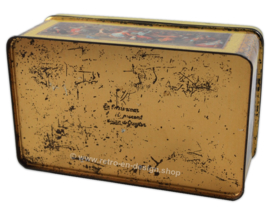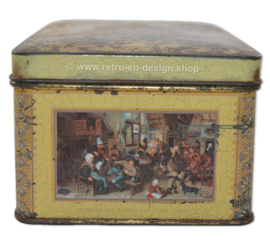A R C H I V E
Vintage tin by DE GRUYTER with images of paintings
SKU: 1281Vintage tin by DE GRUYTER with images of paintings.
- Manufacturer: Nederlands Vereenigde blikfabriek
- Manufacturing date: 1963
Vintage tin for DE GRUYTER with paintings by old Flemish master painters.
Description
This vintage tin from 1963 has a rectangular shape and is equipped with a hinged lid with roll edge. The hinge is a recessed hinge with loose tabs. The decoration of this tin consists of a yellow colored background with crackle motif and images of paintings on each side.
On the lid a picture of "De Dorpsschool" from Braeceleer. On the front and back "De Dorpskermis" by David Vinckboons. On the short sides "Interior with farmers from Corn Dusart.
Text in relief at the bottom: And better where, and 10 percent discount, only the Gruyter. (Dutch translated).
Condition
This tin is in an original vintage condition from 1963 and has traces of wear and tear along with traces of use.
Size
- Height: 8 cm.
- Length: 18.4 cm.
- Width: 11.2 cm.
Ferdinand de Braekeleer (Antwerp, 12 February 1792 – Antwerp, 16 May 1883), sometimes spelled as Ferdinand de Braeckeleer, was a Flemish painter. He is known for his historical paintings and is called 'the Elder' to distinguish him from his son with the same name (Ferdinand de Braekeleer the Younger), who was also a painter.
Ferdinand was born in a poor family. After his parents died he was admitted to the Art school for orphans of Mathieu Ignace van Brée in Antwerp. He continued his education at the Royal Academy for Fine Arts of Antwerp. His paintings received several prizes in 1809 and 1811. In 1813 he made his reputation at the Salon de Paris with his work Aeneas die Anchises redt uit de brand van Troje ("Aeneas saving Anchises from the fire of Troy").
Early on, De Braekeleer decided that he wanted to make a living as a painter and he tried out several genres to find out which one would most likely bring him most success. In addition to historical paintings, he also painted religious paintings, such as St. Sebastiaan[citation needed] for the Church of Our Lady of the Vineyard in Wijnegem (current location unknown).
At the Antwerp art exhibition of 1819 he exhibited four paintings, of which Tobias bezorgt het zicht aan zijn vader terug (Tobias Restoring his Father's Sight) won him the Dutch Prix de Rome in the category of historical paintings. This prize provided him with a scholarship that allowed him to study in Italy to improve his skills. He spent 1821 and 1822 in Italy. Together with his tutor Van Brée (who joined him in Rome) he visited several Italian cities, including Naples, Ancona, Firenze, Bologna and Venice. Fascinated by these Italian cities and their landscape, he filled a sketchbook with crayon drawings of landscapes and city views, which is currently on display in the Bibliotheque Royale Albert (Royal Albert Library) in Brussels.
After his return to Belgium, De Braekeleer lived in his home town Antwerp. He created works inspired by the old Flemish masters.
David Vinckboons (baptized 13 August 1576 – c.1632 ) was a Dutch Golden Age painter born in Mechelen, Southern Netherlands. Vinckboons, whose name is often spelled as Vingboons, Vinghboons, Vinckebonis or Vinckboom, had at least ten children. His sons were the cartographer and watercolorist Johannes and the architects Justus and Philip. Vinckboons himself died in Amsterdam.
Vinckboons was one of the most prolific and popular painters and print designers in the Netherlands. Himself influenced by Pieter Bruegel the Elder, he was instrumental — together with Hans Bol and Roelant Savery — in the development of genre painting in the northern Netherlands.
Vinckboons was born in Mechelen. The family moved to Antwerp around 1580, and then to Middelburg after the Spanish occupation of Antwerp in 1585. It is not likely they moved for religious reasons to Amsterdam. His father became a citizen in 1591, but none of his grandchildren were baptized in a Calvinist church. In 1602 David married in Leeuwarden to Agneta van Loon, the daughter of a notary. Then he lived in Sint Antoniesbreestraat like many other artists and painters. According to Karel van Mander he did not have any teacher other than his father Phillipe, a painter on canvas with watercolors, an art form practiced mainly in his birthplace of Mechelen.
Cornelis Dusart (April 24, 1660 – October 1, 1704) was a Dutch genre painter, draftsman, and printmaker.
He was born in Haarlem. Dusart was a pupil of Adriaen van Ostade from about 1675 to 1679, and was accepted into the Haarlem Guild of St. Luke in 1679. His works are similar in style and subject to those of his mentor. Especially notable are his highly finished drawings of peasants, depicted singly in colored chalks and watercolor. He died in Haarlem.
Some translations come from an automated system and may contain errors.
























